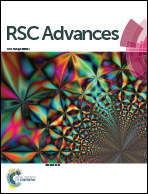Impedimetric detection of 2,4,6-trinitrotoluene using surface-functionalized halloysite nanotubes†
Abstract
Herein, we report the application of amine-surface-functionalized halloysite nanotubes (HAs) as active materials for the quantitative detection of 2,4,6-trinitrotoluene (TNT). The findings indicated that HA could selectively capture TNT via a strong reaction between the amine groups on its surface and the TNT molecules. Plate electrodes were fabricated from HA to evaluate its TNT-sensing capacity by electrochemical impedance spectroscopy. Upon binding with TNT, the proton conductivity on the HA plate electrodes increased linearly with the TNT concentration from 1.0 × 10−11 M to 1.0 × 10−4 M. The HA plate electrodes exhibited good sensitivity with a detection limit of 1.05 × 10−12 M. Subsequently, the cycling measurements of the TNT binding/removal were performed on the HA plate electrode, and the material exhibited high stability, good regenerative ability, and good reversibility without a significant decrease in efficiency. The present work highlights the significant application potential of HAs for the electrochemical detection of TNT.



 Please wait while we load your content...
Please wait while we load your content...